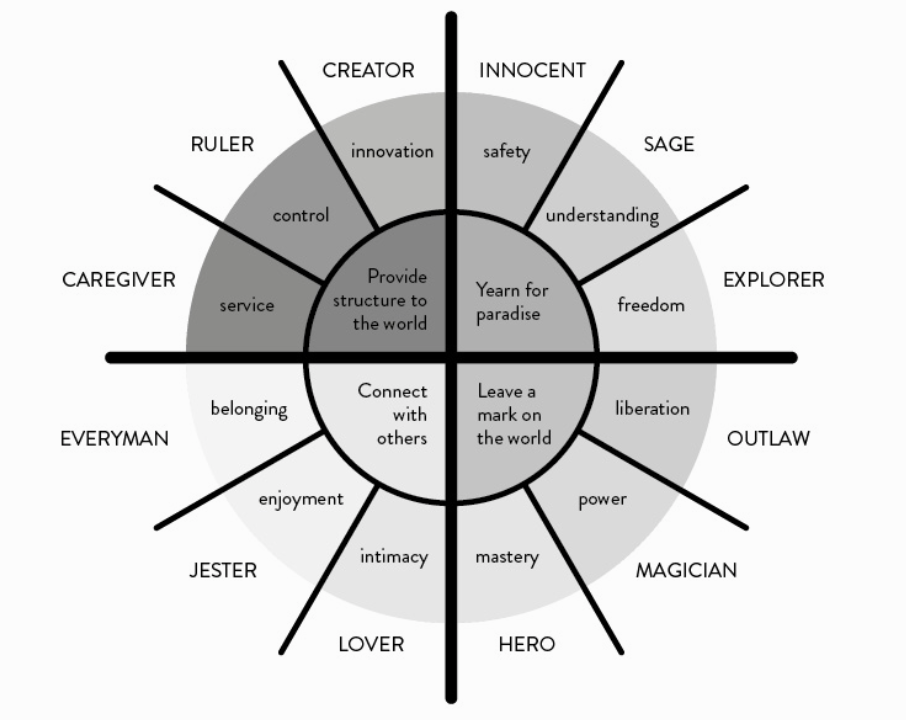It is my view that APEST, viewed as five key archetypes latent in all creation, gives us a remarkable framework within which to broadly understand and organize many important categories of human thought and endeavor. Of course, there are more archetypes in culture than simply five, but if you consider that Carl Jung, after a lifetime of study, listed only twelve personal archetypes, the fivefold typology actually carries a lot of culture-shaping potency. See if you can find links with Jung’s archetypes of personality and 5Q sensibilities. The three layers of the diagram show archetypes (outer level), purposes (middle level) and motivations (center).

There are many correspondences with APEST. Look at the core motivations (at the center)—then think of the obvious correlations to the fivefold. Then look at the archetypes (the outer ring) themselves; his explorer, creator, and hero are strongly apostolic in nature; the prophetic corresponds to the outlaw, jester, and magician; the shepherd to the caregiver, lover, everyman, etc. Do your soft eyes see the pattern?
But we not only see real traces of APEST in the enigmatic depths of the human unconscious; we only have to look at our pantheon of heroes and villains across culture through the lens of the fivefold to observe the five APEST archetypes in embodied forms. As we [recognize], our heroes reflect back to us what we believe is truly important—that is the very purpose of a hero. Think about your heroes; what do they say about you?
It would be a great exercise for the reader to ponder the various super-heroes movies and comics and try to recategorize the heroes and villains using the fivefold types. I actually know a writer who is contracted to write an action hero book series, based on the APEST archetypes.
Perhaps one of the most common ways we experience the use of archetypes in popular culture is in the form of the ubiquitous personality tests available today. Almost all of these (e.g., MBTI, StrengthsFinder, Enneagram) are based on some form of ideal or exemplary personality trait, or archetype. For instance, Isabel Myers (one of the founders of the Myers-Briggs Personality Profile) developed the entire MBTI profile around four temperament and character archetypes each with their own sub-types. David Keirsey went on to refine these to four foundational archetypes which are then subcategorized into the types we know today; they are Artisans (SPs), Guardians (SJs), Idealists (NFs), and Rationals (NTs). Once again, note the glaring similarity to the APEST typology listed in Ephesians 4. The MBTI archetypes have undoubtedly delivered great insights into human motivation, character, traits, strengths, flaws, and so on. They have huge resonance with us because they describe who we are by appealing to the universal traits and patterns already existing in individuals, society and culture.
An approach to the fivefold using Myers-Briggs typology has been developed by people like Jeremie Kubicek and Steve Cockram of GiANT Worldwide. In their model called the Five Voices, they filter MBTI through an APEST lens; the result of this is a typology of five kinds of “voices.” They are: the Pioneer, Creative, Connector, Nurturer and Guardian. Another example of a psychometric profile based on the use of archetypes unnervingly similar to the fivefold is found in the writings of Harvard Law professor Erica Ariel Fox. Written to help people learn to navigate high-stakes interactions—from business deals, client calls, and team meetings to family arguments, landlord disputes, and parent-teacher conferences—she talks about the Dreamer, the Thinker, the Lover, the Warrior, the Lookout, and the Voyager. Look at them; these turn out to be but variations of the primal APEST archetypes in a different guise.
One of the most novel applications of the fivefold typology is that being used by a women’s magazine called Tapestry. The magazine is decidedly Christian in flavor but is dedicated to helping all young women understand their true significance in ways that are relevant in terms of broader culture. The vision is to speak to women through the voices of the fivefold ministry vocations—what they call the five personas—these being the Visionary, the Messenger, the Storyteller, the Nurturer and the Teacher. The art, photography and articles are all built around the development of these five personas. Their descriptors of each of the personas on their website are in my opinion outstanding.
In many ways, this personality-linked aspect of APEST comes very close to being an identity issue and not just a matter of function and calling. It is quite conceivable that the fivefold could be used as a means to profiling personality and helping people live into their unique sense of identity as a follower of Christ.

